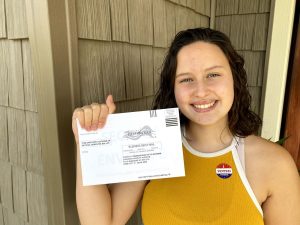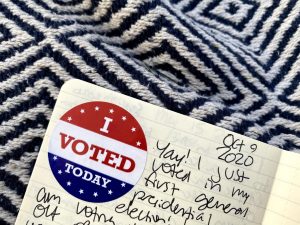
I recently sent in my ballot, casting my vote in a general presidential election for the first time ever. The pandemic has complicated the voting process, but nevertheless I was excited to participate in the process. I chose to vote by mail because I got a request form in the mail and it seemed like an easy way to get my vote in ahead of the election, while potentially avoiding lines at a physical polling place.
If you are eligible to vote this election and have not figured out how you are going to do that yet, make a voting plan! That starts with registering to vote. If you want to vote at an Iowa address, you can do that on this website. If you aren’t sure about your registration address or status, you can check that on the Hawk the Vote website.
Next, you should figure out how you want to vote. You can vote by mail, vote early at in-person satellite locations, or vote on election day, November 3. It is key to plan ahead if you don’t want to vote on election day. For mail voters, ballot requests (note: not the actual ballots) need to be received by Iowa county auditors by October 24. The actual ballots need to be sent back by November 2. You can track your absentee ballot on this webpage.

For more details on how to register to vote and the different voting format, here are some helpful links:
- The Daily Iowan published a comprehensive guide to the 2020 election, with information on registration, different ways to vote, polling locations, and candidate bios.
- The Daily Iowan also published a shorter article focusing on early voting.
- After interviewing Secretary of State Paul Pate and Johnson County Auditor Travis Weipert, I made this Twitter thread with information on voting by mail.
- Secretary of State Paul Pate’s website has important pages that I mentioned earlier in this post, like the absentee ballot tracker and voter registration page. The website also has information on voting as a felon and finding your polling place. The home page is linked here.
- If you live in Johnson County, you can refer to Weipert’s Twitter as a source of election news. Here is a link to his thread about drive-through voting.
- The on-campus resource for all-things-elections is Hawk the Vote, whose website I have linked here.
If you haven’t already, please take the time to check out these resources and figure out how you will be casting your ballot this election.

